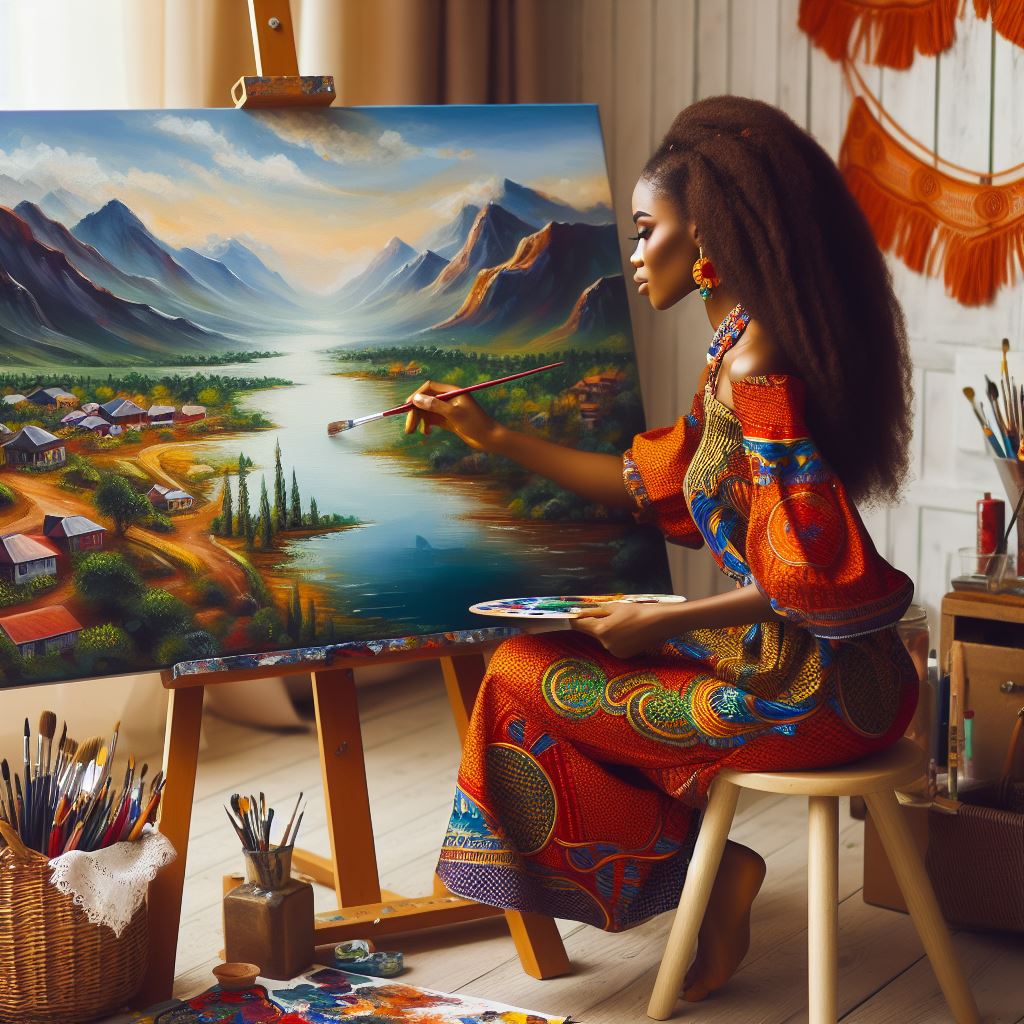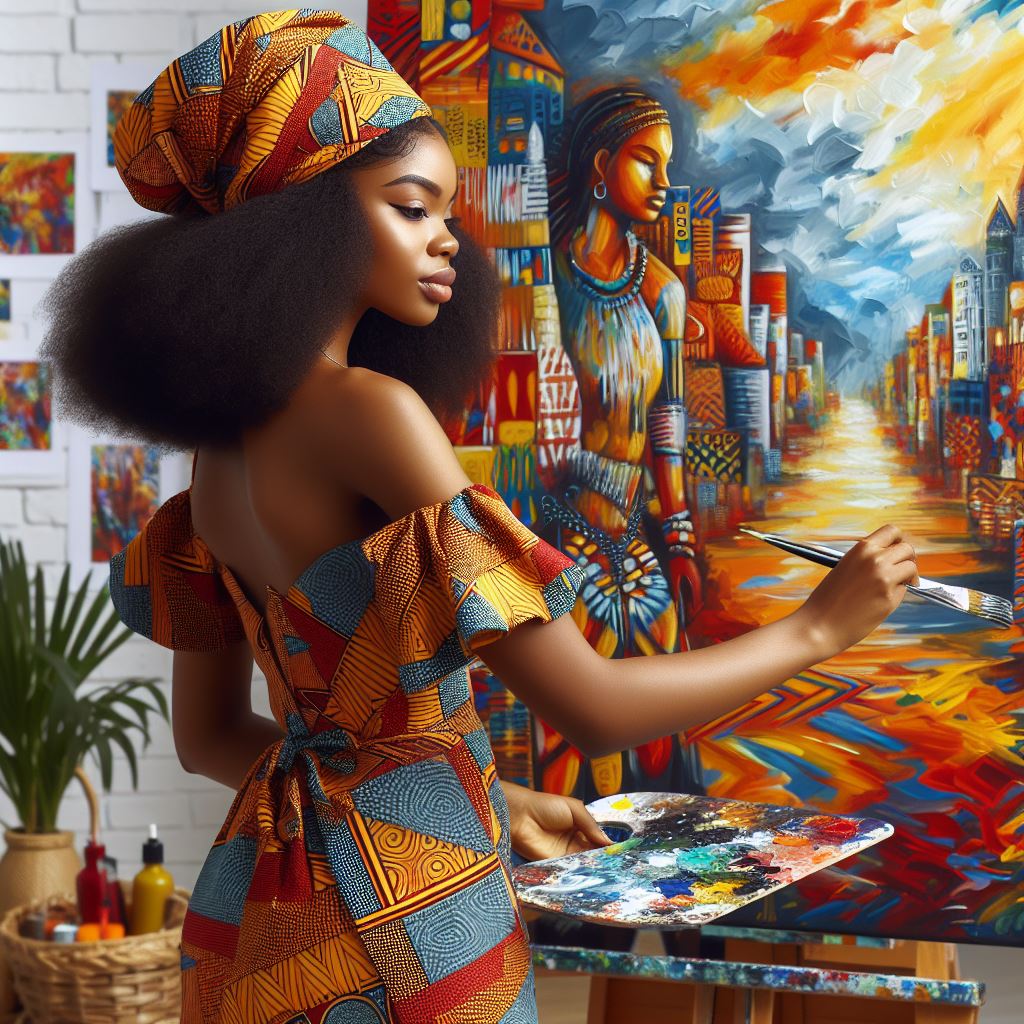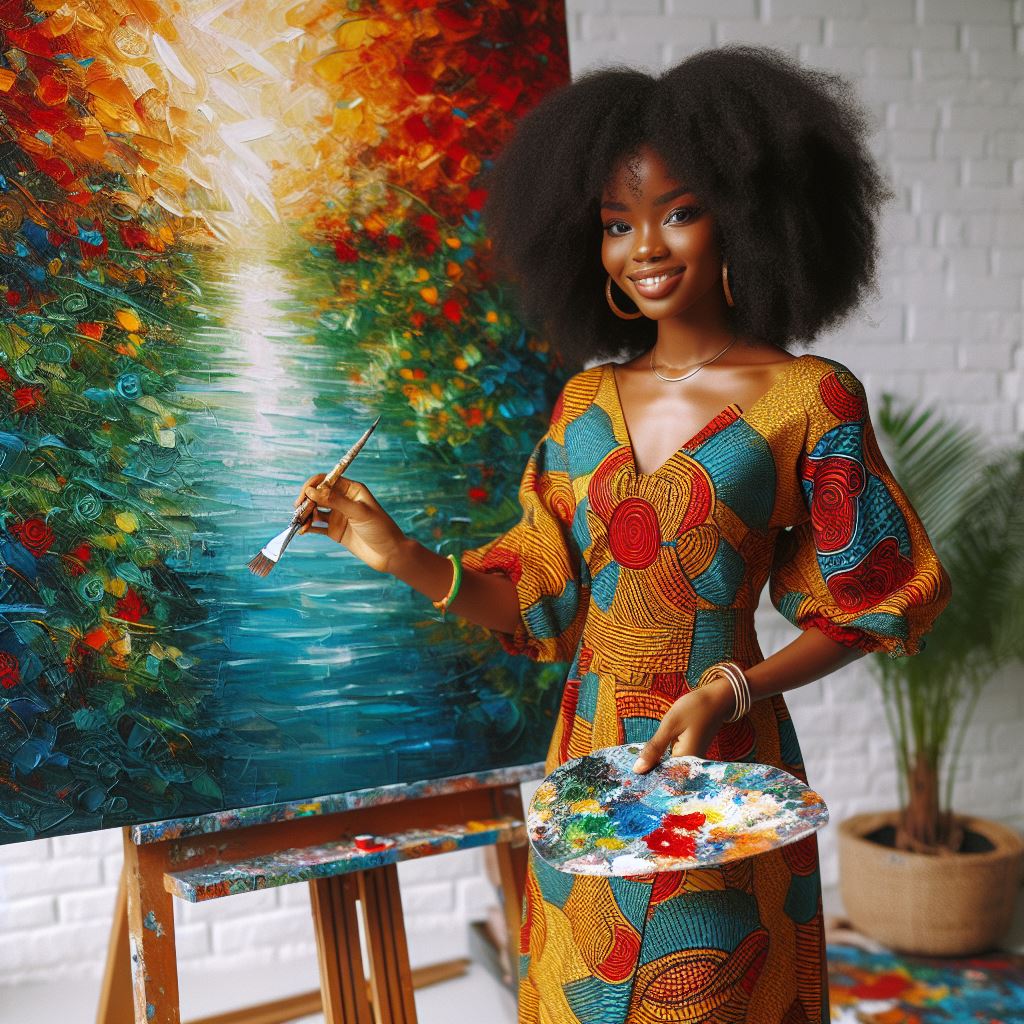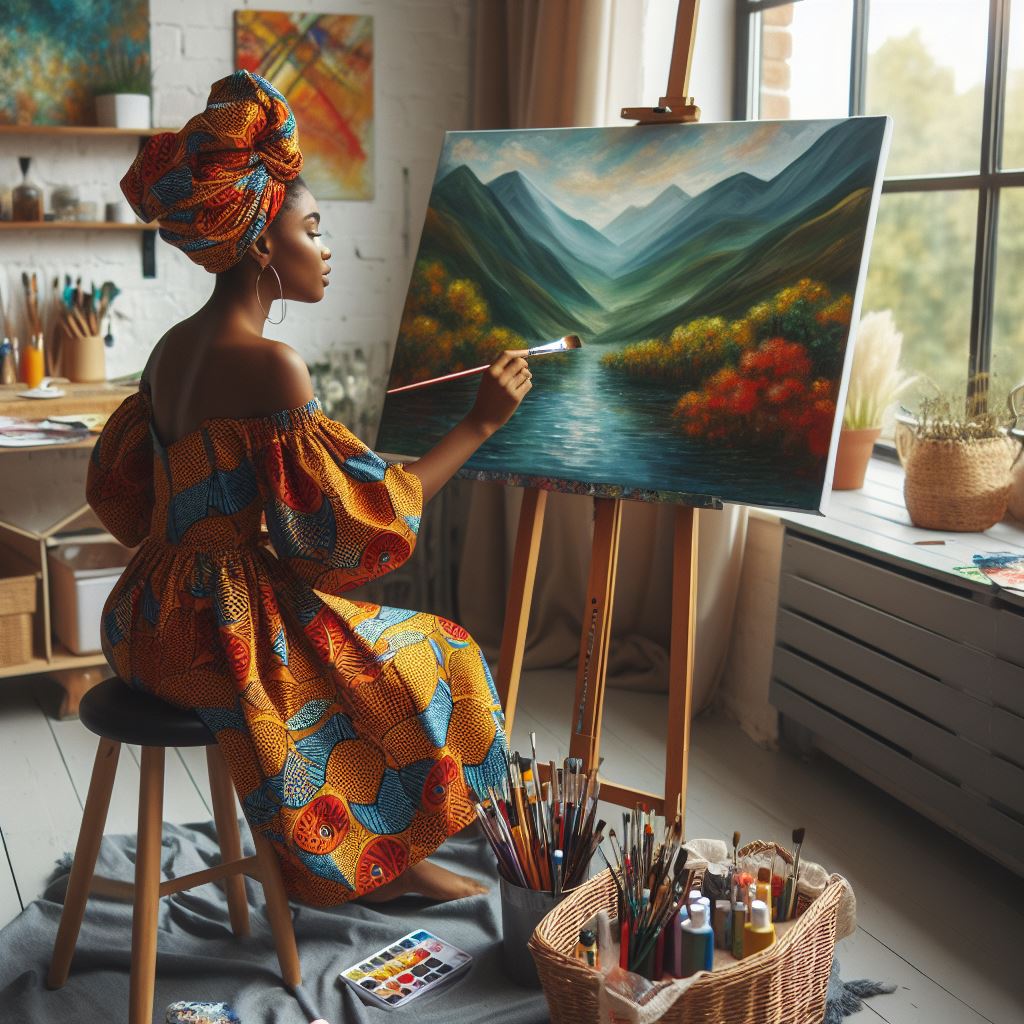Introduction
This blog introduces the influential figures of Nigerian art collectors and patrons, who play a crucial role in the Nigerian art scene by supporting and promoting local artists.
These individuals are instrumental in preserving Nigeria’s rich cultural heritage, ensuring that traditional and contemporary art forms continue to thrive.
Art collectors and patrons provide essential financial support, buying artworks, funding exhibitions, and sponsoring artists.
Their investments help sustain the art industry, offering artists the resources and platforms they need to develop and showcase their work.
This support is vital for the growth and visibility of Nigerian art, both locally and internationally.
Recognizing these key players highlights their significant contributions to the art world.
They help elevate Nigerian art, bringing it to global audiences and fostering a deeper appreciation for the country’s creative talents.
By celebrating these collectors and patrons, we honor their role in shaping and enriching the vibrant Nigerian art landscape.
The Role of Art Collectors in Promoting Nigerian Art
Art collectors play a vital role in supporting and promoting Nigerian artists through their passion for art.
They contribute significantly to the growth and development of the Nigerian art industry by investing in and showcasing the works of talented artists.
How Art Collectors Support Nigerian Artists
- Art collectors provide financial support to artists by purchasing their artwork, enabling them to continue creating.
- They offer artists exposure by displaying their work in galleries, museums, and private collections, increasing their visibility.
- Art collectors connect artists with other collectors, galleries, and art institutions, facilitating collaborations and opportunities for growth.
Impact of Art Collectors on the Nigerian Art Industry
- Art collectors help raise the profile of Nigerian art both locally and internationally, fostering a greater appreciation for the country’s rich cultural heritage.
- They create a demand for Nigerian art, encouraging artists to produce more diverse and innovative works.
- Art collectors contribute to the preservation of Nigerian artistic traditions and heritage, ensuring that future generations can continue to appreciate and learn from these artworks.
Overall, art collectors are essential stakeholders in the Nigerian art scene, playing a crucial role in its growth, sustainability, and global recognition.
Their passion and dedication to supporting artists have a lasting impact on the artistic landscape of the country.
By investing in Nigerian art and artists, collectors not only promote creativity and cultural exchange but also contribute to the socio-economic development of the nation.
Their efforts help to build bridges between artists, collectors, and art enthusiasts, fostering a vibrant and dynamic art community in Nigeria.
Read: Exploring Semiotics in Communication Arts
Profiles of Renowned Nigerian Art Collectors
Here, we will showcase the profiles of three top Nigerian art collectors: Yemisi Shyllon, Olu Amoda, and Sammy Olagbaju.
Yemisi Shyllon: A Pillar of Nigerian Art
Yemisi Shyllon stands as a towering figure in the Nigerian art world.
Known for his extensive collection, Shyllon has amassed over 7,000 pieces of traditional and contemporary Nigerian art.
His collection includes sculptures, paintings, and photographs, showcasing the rich diversity of Nigerian artistic expression.
Shyllon’s dedication to preserving and promoting Nigerian art led him to establish the Yemisi Shyllon Museum of Art at Pan-Atlantic University.
This museum not only houses his vast collection but also serves as an educational resource, fostering appreciation and understanding of Nigerian art among students and the public.
Shyllon’s influence extends beyond his collection; he actively supports emerging artists through grants and scholarships, ensuring the future of Nigerian art.
Olu Amoda: Sculptor and Collector Extraordinaire
Olu Amoda is celebrated both as a sculptor and an art collector.
His unique sculptures, often crafted from recycled materials, have gained international acclaim.
As a collector, Amoda focuses on contemporary Nigerian art, seeking out innovative and boundary-pushing works.
He believes in the importance of nurturing young talent and often acquires pieces from up-and-coming artists.
Amoda’s commitment to the art community is evident in his involvement in various art initiatives and exhibitions.
He regularly curates shows that bring together artists from different backgrounds, fostering a sense of community and collaboration.
Through his dual roles as an artist and collector, Amoda significantly shapes the Nigerian art landscape, promoting creativity and sustainability.
Sammy Olagbaju: Patron of the Arts
Sammy Olagbaju was a renowned art collector and patron whose legacy continues to influence the Nigerian art scene.
His collection, which spans several decades, includes works by some of Nigeria’s most prominent artists, such as Bruce Onobrakpeya and Ben Enwonwu.
Olagbaju’s passion for art was not limited to collecting; he was a fervent supporter of art education and institutions.
He served on the boards of several art organizations, including the African Artists’ Foundation, where he championed the growth and development of Nigerian art.
Olagbaju’s contributions to the art world are manifold; he was instrumental in organizing exhibitions and providing platforms for artists to showcase their work.
His dedication to the arts has inspired a new generation of collectors and patrons, ensuring the continued vitality of Nigerian art.
Contributions to the Nigerian Art World and Their Influence in the Art Community
The contributions of Yemisi Shyllon, Olu Amoda, and Sammy Olagbaju have profoundly impacted the Nigerian art world.
Their efforts have not only preserved Nigeria’s artistic heritage but also propelled it onto the global stage.
By supporting artists, funding institutions, and creating spaces for art to flourish, they have ensured that Nigerian art remains dynamic and relevant.
Their influence extends beyond their collections; they inspire others to value and invest in Nigerian art.
Through their dedication and vision, Shyllon, Amoda, and Olagbaju have solidified their places as pillars of the Nigerian art community, fostering a rich and vibrant cultural landscape for future generations.
Read: Developing Critical Thinking in Language Arts
The significance of art patrons in Nigerian art history
The Historical Role of Art Patrons in Nigeria
Art patrons have played a crucial role in the development and preservation of Nigerian art throughout history.
Traditionally, Nigerian art has been deeply embedded in the cultural, religious, and social fabric of various communities.
Art patrons, including royal figures, religious leaders, and wealthy individuals, have historically supported artists by commissioning works for religious ceremonies, royal courts, and public celebrations.
These patrons ensured that artists could sustain their craft, pass down their skills to future generations, and continue to produce culturally significant artworks.
In pre-colonial Nigeria, kings and chiefs were prominent patrons of the arts.
They commissioned sculptures, textiles, and ceremonial artifacts to reflect their power and prestige.
For instance, the Yoruba kings, or Obas, supported the creation of intricate bronze and ivory sculptures that depicted their reign and deities.
Similarly, the Benin Kingdom was known for its elaborate bronze plaques and statues, funded by the royal court to document historical events and honor ancestors.
The Influence of Past Art Patrons on the Nigerian Art Scene
The influence of past art patrons on the Nigerian art scene is profound and enduring.
Their patronage has shaped the artistic traditions that are still celebrated today.
The works commissioned by historical patrons have become iconic symbols of Nigeria’s cultural heritage, influencing contemporary artists and inspiring new generations.
The legacy of these patrons is evident in the continued reverence for traditional art forms and the preservation of techniques passed down through generations.
Modern art patrons in Nigeria, inspired by their historical counterparts, have continued to support the arts in transformative ways.
Notable figures such as Yemisi Shyllon, Olu Amoda, and Sammy Olagbaju have followed in the footsteps of traditional patrons by investing in the arts and fostering a vibrant art community.
They have established museums, funded exhibitions, and created platforms for emerging artists, ensuring the growth and international recognition of Nigerian art.
These contemporary patrons draw from the historical tradition of patronage while adapting to the changing landscape of the art world.
By supporting both traditional and contemporary artists, they bridge the gap between past and present, highlighting the evolution of Nigerian art.
Their efforts have not only preserved Nigeria’s artistic heritage but also propelled it onto the global stage, making Nigerian art a significant player in the international art market.
Generally, the historical role of art patrons in Nigeria has been pivotal in shaping the country’s rich artistic legacy.
From the royal courts of the Benin and Yoruba kingdoms to the modern collectors and patrons of today, their influence has ensured the preservation and growth of Nigerian art.
The continued support from art patrons fosters a dynamic and thriving art scene, celebrating Nigeria’s past while looking forward to its artistic future.
Read: Student Experiences: Life in Communication Arts

Contemporary art patrons in Nigeria
The Work of Modern Art Patrons: Tokini Peterside, Kabir Mohd Rufai, and Ruth Obih
Tokini Peterside: A Visionary Art Patron
Tokini Peterside is a prominent figure in the Nigerian art scene, known for her dedication to promoting contemporary African art.
She founded ART X Lagos, West Africa’s premier international art fair, in 2016.
This platform showcases the works of emerging and established African artists, attracting collectors, curators, and art enthusiasts from around the world.
Peterside’s vision has significantly elevated the profile of Nigerian art on the global stage.
Her commitment to fostering dialogue and engagement in the art community has created new opportunities for artists to gain exposure and connect with a broader audience.
Kabir Mohd Rufai: Championing Cultural Heritage
Kabir Mohd Rufai is a passionate art patron whose work focuses on preserving Nigeria’s cultural heritage while promoting contemporary art.
As a collector, he has amassed a diverse collection that includes traditional and modern Nigerian artworks.
Rufai supports various art initiatives, including funding exhibitions and sponsoring young artists.
His efforts have been instrumental in bridging the gap between traditional art forms and contemporary practices.
By emphasizing the importance of cultural heritage, Rufai ensures that the rich history of Nigerian art continues to inspire and influence future generations of artists.
Ruth Obih: Empowering Artists and Innovators
Ruth Obih, a prominent real estate entrepreneur, is also a dedicated patron of the arts.
She founded 3INVEST Art, an initiative that integrates art into real estate spaces, creating opportunities for artists to display their work in innovative settings.
Obih’s approach not only supports artists financially but also brings art to new audiences, making it more accessible.
Her commitment to empowering artists extends to providing mentorship and resources, helping them navigate the complexities of the art market.
By blending art with everyday environments, Obih is redefining how art is experienced and appreciated in Nigeria.
These Individuals Are Shaping the Future of Nigerian Art Through Their Support and Patronage
The contributions of Tokini Peterside, Kabir Mohd Rufai, and Ruth Obih are reshaping the landscape of Nigerian art.
Their support and patronage are crucial in creating sustainable opportunities for artists and fostering a vibrant art community.
Tokini Peterside’s ART X Lagos has become a vital platform for African artists, enhancing their visibility and marketability.
By organizing this international art fair, Peterside has opened doors for Nigerian artists to participate in the global art market, encouraging cross-cultural exchanges and collaborations.
Kabir Mohd Rufai’s dedication to preserving cultural heritage while promoting contemporary art ensures that the rich history of Nigerian art is not lost.
His support for traditional and modern artists alike helps maintain a dynamic and evolving art scene that honors its roots while embracing innovation.
Ruth Obih’s integration of art into real estate and her mentorship programs empower artists to explore new opportunities and reach wider audiences.
Her efforts in making art accessible in everyday spaces help demystify art, encouraging a broader appreciation and engagement from the public.
These modern art patrons support individual artists’ careers and contribute to Nigeria’s art industry’s growth and sustainability.
They shape the future of Nigerian art with innovative approaches and dedication, keeping it vibrant and influential globally.
Read: Introduction to African and Asian Studies in Nigeria
Challenges faced by art collectors and patrons in Nigeria
Art collectors and patrons play a crucial role in supporting Nigerian artists. However, they encounter several challenges that hinder their efforts to contribute to the growth of the art industry in Nigeria.
The Challenges That Art Collectors and Patrons Encounter in Supporting Nigerian Artists
Art collectors and patrons in Nigeria face numerous challenges in their efforts to support local artists.
These obstacles often hinder the growth and development of the Nigerian art industry, affecting both artists and patrons alike.
Funding and Financial Constraints
One of the primary challenges is the lack of adequate funding. Many collectors and patrons struggle to secure the financial resources necessary to support artists and art initiatives.
This financial constraint limits their ability to purchase artworks, sponsor exhibitions, and fund art projects. Additionally, the high cost of art materials and production can deter potential patrons from investing in the arts.
Limited Access to Global Markets
Another significant challenge is the limited access to global markets.
Nigerian artists often face difficulties in gaining international exposure, which can restrict their opportunities for growth.
Collectors and patrons may find it challenging to promote Nigerian art on the global stage due to logistical issues, high shipping costs, and the complexities of navigating international art markets.
Infrastructure and Institutional Support
The lack of robust infrastructure and institutional support is a major hindrance.
There are limited art galleries, museums, and cultural institutions in Nigeria that can provide platforms for artists to showcase their work.
This scarcity of venues restricts the visibility and accessibility of Nigerian art. Additionally, the absence of comprehensive art education programs and professional development opportunities for artists and patrons further exacerbates the problem.
Regulatory and Bureaucratic Hurdles
Regulatory and bureaucratic hurdles also pose significant challenges.
The Nigerian art market lacks standardized regulations, making it difficult for collectors and patrons to navigate legal and administrative processes.
Issues such as ambiguous tax policies, import/export regulations, and intellectual property rights can create uncertainties and dissuade investment in the arts.
These Obstacles Impact the Nigerian Art Industry and Suggest Possible Solutions
These challenges have a profound impact on the Nigerian art industry, stifling its potential for growth and innovation.
The lack of funding and financial constraints limit the ability of artists to produce and exhibit their work.
This financial instability can discourage emerging artists from pursuing their careers, leading to a talent drain in the industry.
Limited access to global markets restricts the international recognition of Nigerian artists, reducing their opportunities for career advancement and financial success.
Without global exposure, Nigerian art remains underrepresented in the international art community, missing out on potential collaborations and cultural exchanges.
The inadequate infrastructure and institutional support hamper the development of a thriving art ecosystem.
The scarcity of exhibition spaces and educational programs stifles artistic expression and hinders the professional growth of artists.
Moreover, the lack of regulatory clarity and bureaucratic hurdles creates an environment of uncertainty, deterring potential investors and patrons.
Possible Solutions
To address these challenges, several solutions can be implemented:
- Increase Funding and Financial Support: Government and private sector initiatives should be established to provide grants, subsidies, and sponsorships for artists and art projects. Creating dedicated art funds can help alleviate financial constraints and promote artistic production.
- Expand Access to Global Markets: Establishing partnerships with international art fairs, galleries, and cultural institutions can help Nigerian artists gain global exposure. Developing digital platforms for showcasing and selling Nigerian art can also enhance international accessibility.
- Enhance Infrastructure and Institutional Support: Investing in the development of art galleries, museums, and cultural centers will provide more platforms for artists to exhibit their work. Additionally, implementing comprehensive art education programs and professional development opportunities will nurture talent and foster a skilled art community.
- Streamline Regulations and Bureaucratic Processes: Simplifying tax policies, import/export regulations, and intellectual property rights will create a more favorable environment for art collectors and patrons. Establishing clear and transparent guidelines will reduce uncertainties and encourage investment in the arts.
By addressing these challenges and implementing these solutions, the Nigerian art industry can thrive and achieve its full potential.
Enhanced support from collectors and patrons, combined with strategic initiatives, will foster a vibrant and sustainable art ecosystem in Nigeria.
Conclusion
In this blog post, we have explored the lives and contributions of famous Nigerian art collectors and patrons.
These individuals have played a crucial role in shaping the art landscape in Nigeria.
Through their support, they have helped to nurture and promote Nigerian artists, both locally and on the global stage.
Their passion for collecting art has not only preserved the country’s cultural heritage but also propelled its contemporary art scene forward.
Their investments have not only supported artists but have also contributed to the growth of the art market in Nigeria.
By providing financial backing, creating opportunities for artists, and fostering a community of art enthusiasts, these collectors and patrons have been instrumental in developing a thriving art culture in the country.
Lastly, it is evident that art collectors and patrons play a vital role in the art ecosystem of Nigeria.
Their dedication, vision, and commitment to supporting artists have helped to elevate Nigerian art to new heights.
Without their influence and contributions, the vibrant art scene in Nigeria would not be as vibrant and dynamic as it is today.




